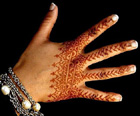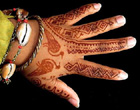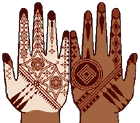|
Hair, skin, and fingernails are made of keratin. Henna stains keratin red-orange to near black; different recipes, temperature, time, and application techniques create the variation in stain color. Henna's stain is not opaque, it is translucent; henna color does not mask the skin tone, it blends with it. Henna applied to skin stains the top, dead, epidermal cells above the melanin-bearing layer. Thus, the pigment of dark skin cannot mask henna, as it lies underneath it. The red-orange to black/brown henna color will be a translucent layer over the natural color of the skin.
Similarly, a bittersweet color crayon line drawn onto a tan, brown or black paper will make a translucent mark, creating a different effect on each, while being the same color. The bittersweet will appear as a dark mark on pale paper, a light mark on black paper, and tone against tone on brown paper. Bittersweet henna will appear dark on pale skin, and a warm bittersweet orange on darkest skin. The colors in each case are translucent, not opaque, so they blend with the underlying skin tone. Heavier applications of higher quality henna will make a more saturated stain; lighter applications will make a more transparent stain. |




